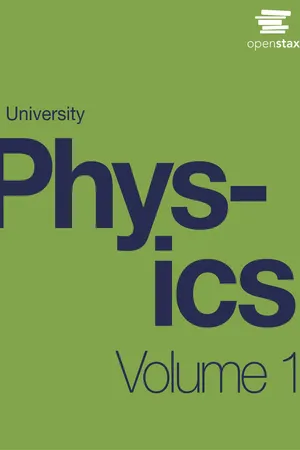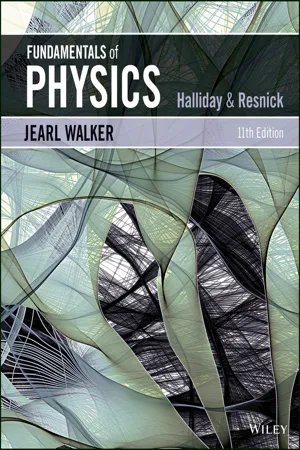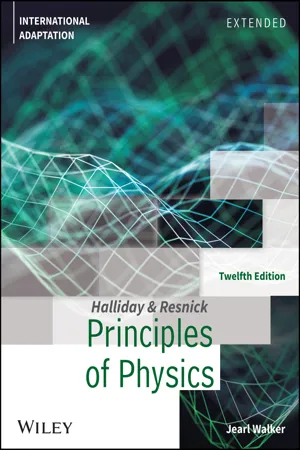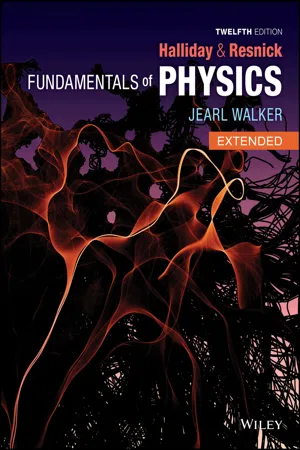Physics
Potential Energy Graphs and Motion
Potential energy graphs in physics depict the relationship between an object's potential energy and its position. These graphs show how potential energy changes as an object moves within a force field, such as gravitational or spring force. By analyzing these graphs, one can understand the behavior and motion of the object in different positions and how energy is transformed between potential and kinetic forms.
Written by Perlego with AI-assistance
Related key terms
1 of 5
7 Key excerpts on "Potential Energy Graphs and Motion"
- No longer available |Learn more
Physics for Scientists and Engineers
Foundations and Connections, Extended Version with Modern Physics
- Debora Katz(Author)
- 2016(Publication Date)
- Cengage Learning EMEA(Publisher)
A potential energy curve alone is not enough to visualize the conservation of me- chanical energy, however. Instead, we must create an energy graph to represent a system’s mechanical energy E, potential energy U, and kinetic energy K on a sin- gle set of axes. The energy graph starts with a U curve to represent the potential energy. Then, be- cause we are only considering systems that have constant mechanical energy, the me- ENERGY GRAPH Tool Copyright 2017 Cengage Learning. All Rights Reserved. May not be copied, scanned, or duplicated, in whole or in part. WCN 02-300 8-8 Energy Graphs 233 All content on this page is © Cengage Learning. U U g = mgy Particle y y 0 A. FIGURE 8.32 Poten- tial energy curves for A. gravity near the surface of a large ob- ject such as the Earth, B. universal gravity, and C. Hooke’s law. U r r B. U G = m 1 m 2 ` r -Gm 1 m 2 C. U = 0 x U x 1 2 U e = kx 2 chanical energy does not depend on the relative position of the particles in the system. So, E is represented by a horizontal line on an energy graph (“the horizontal E line”). We do not actually plot kinetic energy on the energy graph, but we find it in the following way. The kinetic energy is given by (Eq. 8.11) K 5 E 2 U So, on the energy graph, kinetic energy is represented by the vertical space between the horizontal E line and the potential energy curve. To see how to use an energy graph, consider a familiar physical situation: a ball thrown straight upward from the top of a tall building (Fig. 8.33A) with a certain initial velocity. The (nearly) isolated system consists of the ball and the Earth, and we assume mechanical energy of the system is conserved. We start by drawing a potential energy curve. For this situation, it looks like the one in Figure 8.32A. The mechanical energy of the system is constant and is therefore represented by the hori- zontal line shown in Figure 8.33B. - David Halliday, Jearl Walker, Patrick Keleher, Paul Lasky, John Long, Judith Dawes, Julius Orwa, Ajay Mahato, Peter Huf, Warren Stannard, Amanda Edgar, Liam Lyons, Dipesh Bhattarai(Authors)
- 2020(Publication Date)
- Wiley(Publisher)
When the mechanical energy of a system is conserved, we can relate the sum of potential energy and kinetic energy at one instant to that at another instant without considering the intermediate motion and without finding the work done by the forces involved. CHAPTER 8 Potential energy and conservation of energy 123 8.3 Reading a potential energy curve LEARNING OBJECTIVES After reading this module, you should be able to: 8.3.1 given a particle’s potential energy as a function of its position x, determine the force on the particle 8.3.2 given a graph of potential energy versus x, determine the force on a particle 8.3.3 on a graph of potential energy versus x, superimpose a line for a particle’s mechanical energy and determine the particle’s kinetic energy for any given value of x 8.3.4 if a particle moves along an x axis, use a potential‐energy graph for that axis and the conservation of mechanical energy to relate the energy values at one position to those at another position 8.3.5 on a potential‐energy graph, identify any turning points and any regions where the particle is not allowed because of energy requirements 8.3.6 explain neutral equilibrium, stable equilibrium, and unstable equilibrium. KEY IDEAS • If we know the potential energy function U(x) for a system in which a one‐dimensional force F(x) acts on a particle, we can find the force as F (x) = - dU dx . • If U(x) is given on a graph, then at any value of x, the force F(x) is the negative of the slope of the curve there and the kinetic energy of the particle is given by K (x) = E mec - U (x) , where E mec is the mechanical energy of the system. • A turning point is a point x at which the particle reverses its motion (there, K = 0). • The particle is in equilibrium at points where the slope of the U(x) curve is zero (there, F(x) = 0). Once again we consider a particle that is part of a system in which a conservative force acts.- eBook - PDF
- William Moebs, Samuel J. Ling, Jeff Sanny(Authors)
- 2016(Publication Date)
- Openstax(Publisher)
In the final section on sources of energy, we will consider energy transfers and the general law of conservation of energy. Throughout this book, the law of conservation of energy will be applied in increasingly more detail, as you encounter more complex and varied systems, and other forms of energy. Chapter 8 | Potential Energy and Conservation of Energy 359 8.1 | Potential Energy of a System Learning Objectives By the end of this section, you will be able to: • Relate the difference of potential energy to work done on a particle for a system without friction or air drag • Explain the meaning of the zero of the potential energy function for a system • Calculate and apply the gravitational potential energy for an object near Earth’s surface and the elastic potential energy of a mass-spring system In Work, we saw that the work done on an object by the constant gravitational force, near the surface of Earth, over any displacement is a function only of the difference in the positions of the end-points of the displacement. This property allows us to define a different kind of energy for the system than its kinetic energy, which is called potential energy. We consider various properties and types of potential energy in the following subsections. Potential Energy Basics In Motion in Two and Three Dimensions, we analyzed the motion of a projectile, like kicking a football in Figure 8.2. For this example, let’s ignore friction and air resistance. As the football rises, the work done by the gravitational force on the football is negative, because the ball’s displacement is positive vertically and the force due to gravity is negative vertically. We also noted that the ball slowed down until it reached its highest point in the motion, thereby decreasing the ball’s kinetic energy. This loss in kinetic energy translates to a gain in gravitational potential energy of the football-Earth system. - eBook - PDF
- David Halliday, Robert Resnick, Jearl Walker(Authors)
- 2018(Publication Date)
- Wiley(Publisher)
What Is Physics? One job of physics is to identify the different types of energy in the world, especially those that are of common importance. One general type of energy is potential energy U. Technically, potential energy is energy that can be associated with the configuration (arrangement) of a system of objects that exert forces on one another. C H A P T E R 8 Potential Energy and Conservation of Energy 8-1 POTENTIAL ENERGY Learning Objectives After reading this module, you should be able to . . . ● A force is a conservative force if the net work it does on a particle moving around any closed path, from an initial point and then back to that point, is zero. Equivalently, a force is conservative if the net work it does on a particle moving between two points does not depend on the path taken by the particle. The gravitational force and the spring force are conservative forces; the kinetic frictional force is a nonconservative force. ● Potential energy is energy that is associated with the configuration of a system in which a conservative force acts. When the conservative force does work W on a particle within the system, the change ∆U in the potential energy of the system is ∆U = −W. If the particle moves from point x i to point x f , the change in the potential energy of the system is ΔU = − ∫ x f x i F(x) dx. ● The potential energy associated with a system consist- ing of Earth and a nearby particle is gravitational potential energy. If the particle moves from height y i to height y f , the change in the gravitational potential energy of the particle–Earth system is ∆U = mg( y f − y i ) = mg ∆y. ● If the reference point of the particle is set as y i = 0 and the corresponding gravitational potential energy of the system is set as U i = 0, then the gravitational potential energy U when the particle is at any height y is U( y) = mgy. ● Elastic potential energy is the energy associated with the state of compression or extension of an elastic object. - eBook - PDF
- David Halliday, Robert Resnick, Jearl Walker(Authors)
- 2020(Publication Date)
- Wiley(Publisher)
. . 8.07 Given a particle’s potential energy as a function of its position x, determine the force on the particle. 8.08 Given a graph of potential energy versus x, deter- mine the force on a particle. 8.09 On a graph of potential energy versus x, superim- pose a line for a particle’s mechanical energy and determine the particle’s kinetic energy for any given value of x. 8.10 If a particle moves along an x axis, use a potential- energy graph for that axis and the conservation of mechanical energy to relate the energy values at one position to those at another position. 8.11 On a potential-energy graph, identify any turning points and any regions where the particle is not allowed because of energy requirements. 8.12 Explain neutral equilibrium, stable equilibrium, and unstable equilibrium. Key Ideas ● If we know the potential energy function U(x) for a system in which a one-dimensional force F(x) acts on a particle, we can find the force as F(x) = − dU(x) dx . ● If U(x) is given on a graph, then at any value of x, the force F(x) is the negative of the slope of the curve there and the kinetic energy of the particle is given by K(x) = E mec − U(x), where E mec is the mechanical energy of the system. ● A turning point is a point x at which the particle reverses its motion (there, K = 0). ● The particle is in equilibrium at points where the slope of the U(x) curve is zero (there, F(x) = 0). This is the same speed that the child would reach if she fell 8.5 m vertically. On an actual slide, some frictional forces would act and the child would not be moving quite so fast. Comments: Although this problem is hard to solve directly with Newton’s laws, using conservation of mechanical energy makes the solution much easier. However, if we were asked to find the time taken for the child to reach the bot- tom of the slide, energy methods would be of no use; we would need to know the shape of the slide, and we would have a difficult problem. - David Halliday, Robert Resnick, Jearl Walker(Authors)
- 2023(Publication Date)
- Wiley(Publisher)
LEARNING OBJECTIVES 186 CHAPTER 8 Potential Energy and Conservation of Energy 3. A turning point is a point x at which the particle reverses its motion (there, K = 0). 4. The particle is in equilibrium at points where the slope of the U(x) curve is zero (there, F(x) = 0). Reading a Potential Energy Curve Once again we consider a particle that is part of a system in which a conservative force acts. This time suppose that the particle is constrained to move along an x axis while the conservative force does work on it. We want to plot the potential energy U(x) that is associated with that force and the work that it does, and then we want to consider how we can relate the plot back to the force and to the kinetic energy of the particle. However, before we discuss such plots, we need one more relationship between the force and the potential energy. Finding the Force Analytically Equation 8.1.6 tells us how to find the change ∆U in potential energy between two points in a one-dimensional situation if we know the force F(x). Now we want to go the other way; that is, we know the potential energy function U(x) and want to find the force. For one-dimensional motion, the work W done by a force that acts on a par- ticle as the particle moves through a distance ∆x is F(x) ∆x. We can then write Eq. 8.1.1 as ∆U(x) = −W = −F(x) ∆x. (8.3.1) Solving for F(x) and passing to the differential limit yield F(x) = − dU(x) _ dx (one-dimensional motion), (8.3.2) which is the relation we sought. We can check this result by putting U(x) = 1 _ 2 kx 2 , which is the elastic poten- tial energy function for a spring force. Equation 8.3.2 then yields, as expected, F(x) = −kx, which is Hooke’s law. Similarly, we can substitute U(x) = mgx, which is the gravitational potential energy function for a particle–Earth system, with a particle of mass m at height x above Earth’s surface. Equation 8.3.2 then yields F = −mg, which is the gravitational force on the particle.- eBook - PDF
- David Halliday, Robert Resnick, Jearl Walker(Authors)
- 2021(Publication Date)
- Wiley(Publisher)
Figure 8.2.2 A child slides down a water slide as she descends a height h. h The total mechanical energy at the top is equal to the total at the bottom. 8.3 READING A POTENTIAL ENERGY CURVE Learning Objectives After reading this module, you should be able to . . . 8.3.1 Given a particle’s potential energy as a function of its position x, determine the force on the particle. 8.3.2 Given a graph of potential energy versus x, deter- mine the force on a particle. 8.3.3 On a graph of potential energy versus x, super- impose a line for a particle’s mechanical energy and determine the particle’s kinetic energy for any given value of x. Additional examples, video, and practice available at WileyPLUS 197 8.3 READING A POTENTIAL ENERGY CURVE Reading a Potential Energy Curve Once again we consider a particle that is part of a system in which a conservative force acts. This time suppose that the particle is constrained to move along an x axis while the conservative force does work on it. We want to plot the potential energy U(x) that is associated with that force and the work that it does, and then we want to consider how we can relate the plot back to the force and to the kinetic energy of the particle. However, before we discuss such plots, we need one more relationship between the force and the potential energy. Finding the Force Analytically Equation 8.1.6 tells us how to find the change ∆U in potential energy between two points in a one-dimensional situation if we know the force F(x). Now we want to go the other way; that is, we know the potential energy function U(x) and want to find the force. For one-dimensional motion, the work W done by a force that acts on a par- ticle as the particle moves through a distance ∆x is F(x) ∆x. We can then write Eq. 8.1.1 as ∆U(x) = −W = −F(x) ∆x. (8.3.1) Solving for F(x) and passing to the differential limit yield F(x) = − dU(x) _ dx (one-dimensional motion), (8.3.2) which is the relation we sought.
Index pages curate the most relevant extracts from our library of academic textbooks. They’ve been created using an in-house natural language model (NLM), each adding context and meaning to key research topics.






